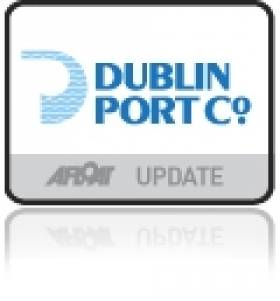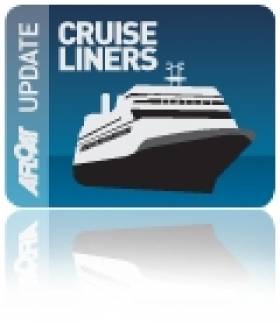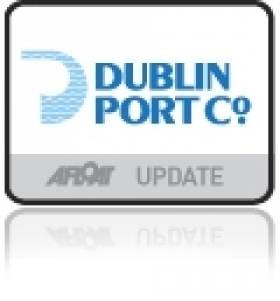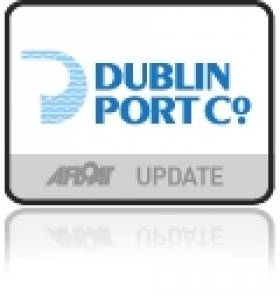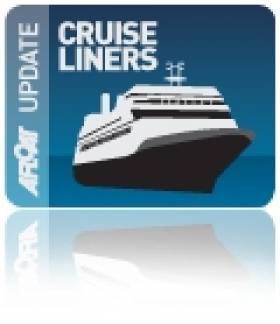Displaying items by tag: Dublin Port Company
#dublinport – Dublin Port Company today welcomed the decision by An Bord Pleanála to grant permission for the Alexandra Basin Redevelopment (ABR) Project which will transform Dublin Port's infrastructure and enable it to service the economy for decades ahead. The project will increase the port's ability to handle large ships by deepening and lengthening three kilometres of the port's seven kilometres of berths. It will also deepen the port to provide an entrance channel with a depth of at least 10m.
The ABR Project is the largest single infrastructure development project in the history of Dublin Port. The project is expected to take five years to complete, costing an estimated €230m.
Given the port's sensitive location at the heart of Dublin Bay and Dublin City, the project was subjected to a rigorous assessment by An Bord Pleanála of possible impacts on the environment generally and specifically on protected Natura sites.
Today's decision comes as trade volumes continue to rise at Dublin Port with 2015 set to be a record year. New figures show total throughput (imports and exports) rose by 5.0% in the first half of 2015 with imports growing particularly strongly at 5.6% as the domestic economy improves.
As well as being a record year for cargo, 2015 will be a record year for the port's cruise business with nearly 100 cruise ships bringing 200,000 visitors to Dublin expected for the full year. These include some of the world's largest cruise ships such as MSC Splendida, Royal Princess and Celebrity Silhouette, measuring up to 333m long. Until now these ships have had to reverse into Dublin Port given their lengths. The ABR Project will allow larger ships to routinely call at Dublin, turn within Alexandra Basin and berth as far upriver as East Link Bridge. This will create a positive economic impact for the city, enhance inbound tourism and contribute to the development of Docklands.
The port is also seeing strong growth in ferry passenger numbers, up 4.8% in the six months to June on routes between Dublin and Britain and between Dublin and France.
Eamonn O'Reilly, Chief Executive of Dublin Port Company said: "I am delighted that An Bord Pleanála has granted Dublin Port planning permission for the ABR Project and to say that we can finance the project immediately. The engineering design works are already at an advanced stage and we expect the first phase of works to be tendered and a contractor ready to start by October 2015."
"The ABR Project is a complex undertaking that required co-ordinated planning with a range of bodies including Dublin City Council, the National Roads Authority (NRA), the National Transport Agency (NTA), ESB Networks and Eirgrid. I am pleased to say that all of our dealings were positive and supportive. We have achieved strong consensus on how to deliver this major piece of port infrastructure in a way that is compatible with the operations of other major infrastructure providers within and adjacent to the port."
An Bord Pleanála's planning permission has paved the way for the last remaining steps to deliver the ABR Project in good time. The priority now is for Dublin Port to begin the engineering works as soon as possible. Against a background of strong growth in port volumes, there is still a window of opportunity in which to carry out major construction works before volumes grow to the extent that the port has to turn some trade away during the construction phase.
To capitalise on this window, Dublin Port's next focus is on progressing the other consents required from the Department of Environment, Community and Local Government and from the Environmental Protection Agency (EPA). Having liaised with both organisations throughout the planning application, Dublin Port hopes to secure the necessary consents within months.
The ABR Project is the first major project from Dublin Port's Masterplan 2012 to 2040. While bringing it through the planning process, Dublin Port Company has also been working on smaller projects including a new terminal for imported cars, a new high capacity firewater main and completion of the Alexandra Quay Container Terminal. The redevelopment of eight hectares of land within the port is also underway and Dublin Port Company will shortly lodge a planning application with Dublin City Council to redevelop the port's road network to ensure it has the capacity to handle the doubling in port volumes projected by 2040.
Dublin Port is Ireland's largest port and is one of 83 core ports on the EU's TEN-T network. In October 2014, the EU agreed funding of €2.4m towards Dublin Port Company's costs of bringing the ABR Project through to the point of being ready for construction.1
Following on from this, on 30th June 2015, the European Commission announced further funding of €22.8m for the construction phase of the project. 2 Finally, the project is also under appraisal by the European Investment Bank (EIB) for €100m of long-term debt finance. 3
Eamonn O'Reilly, Chief Executive of Dublin Port Company said: "The positive decsision by An Bord Pleanála and the financial support from the EU and EIB put us in a good position to commence construction works later this year subject to our gaining the remaining necessary consents from the EPA and the Department of the Environment, Community and Local Government. Bringing large infrastructure projects through to the construction phase is a long, detailed and careful process. Given our high growth rates, we intend to review our Masterplan 2012 to 2040 in the first quarter of next year and begin to plan the next major development after the ABR Project."
Dublin Port Company to Pay €8.8m Dividend to the State
#dublinport – Dublin Port Company today announced that it will pay a dividend of €8.8 million to the State for the 2014 financial year. The payment represents 30% of the port's distributable profits for 2014. Since 2007 Dublin Port Company has paid the Government a total of €78.6 million in dividends.
The dividend payment follows a successful year in 2014 for Dublin Port where cargo volumes increased 7.0% year-on-year. Total throughput for the year was 31 million gross tonnes with 7,108 ship arrivals, bringing the port's activity back to the record levels of 2007. Figures for the first trading quarter of 2015 have shown continued growth in import and export trade with cargo volumes up 5.3% on the same period last year. This is the strongest first quarter Dublin Port has had in a decade and surpasses the previous record year of 2007 by 3.0%.
Welcoming the announcement, Minister for Transport, Tourism and Sport Paschal Donohoe T.D. said: "Dublin Port Company made a commitment to make a dividend payment of 30% of its distributable profits to the Exchequer. I am delighted that the port has once again achieved its agreed target. I would like to thank the Board, management and employees of this strategically important State asset for their continued work and contribution. I greatly welcome the manner in which Dublin Port continues to fulfil its mandate of operating an efficient, well-resourced port to facilitate Ireland's trading needs."
Lucy McCaffrey, Chairperson, Dublin Port Company said: "2014 was a very strong year for Dublin Port and I am delighted that we are in a position to pay a healthy dividend to our shareholders. Dublin Port is profitable, committed to sustainable investment and in an excellent position to fund major infrastructural development. We recently financed a €35million redevelopment of the Alexandra Quay Container Terminal and opened a €3.4m trade car terminal at East Wall Road. We are now ready to finance our proposed €230m Alexandra Basin Redevelopment Project, the single largest infrastructural investment project in the history of the port, which we hope to commence later this year."
Mexican Navy Tall Ship Sails into Dublin
#mexicantallship – Dublin Port Company and the Mexican Embassy in Dublin have welcomed one of the world's most magnificent Tall Ships, the 1,800 tonnes and 270 foot long Cuauhtémoc – that had been at anchor in Dublin Bay since Monday – sailed into Dublin city centre this morning for a five day visit to the capital.
The spectacular vessel was met by Dublin Port's tugs Shackleton and Beaufort in a ceremonial escort to mark the ship's arrival, before docking at 10am on Sir John Rogerson's Quay.
As Afloat previously reported last week the windjammer commanded by Captain Pedro Mata, the Cuauhtémoc is a sail training vessel of the Mexican Navy which travels around the world carrying a message of friendship and goodwill. She arrived in Dublin with 225 men and women sailors on board - including trainees of different nationalities - who will participate in a five-day programme of engagements in the capital as part of the 40th anniversary celebration of the establishment of diplomatic relations between Ireland and Mexico.
Highlights of the itinerary include an accompanied tour of the city for crew, a visit to the vessel by President Michael D. Higgins and his wife Sabina Higgins on Sunday, and a special performance by 'The Buena Vibra Latin Jazz Trio with the Royal Irish Academy of Music Percussion Ensemble' on board, as well as the San Patricio Mariachi Band.
Dubliners and visitors to the city hoping to get a closer insight into life on board this magnificent vessel will be able to visit for free while she is berthed at Sir John Rogerson's Quay. Opening times to the public are Wednesday 17th – Saturday 20th June between 10.00 and 19.00, and on Sunday 21st June from 10.00 to 15.00. During her last visit to Dublin as part of the Tall Ship Races 2012, the Cuauhtémoc welcomed over 23,000 visitors on board.
Built in the Celaya shipyards in Bilbao, Spain, the Cuauhtémoc was launched in July 1982. She was the last of four windjammers built by Bilbao shipyards and is named after the last Aztec emperor who was imprisoned and executed by the conquistador, Herman Cortes, in 1525. This will be her fourth visit to Irish waters.
Eamonn O'Reilly, Chief Executive of Dublin Port Company, said: "Dublin Port Company is delighted to welcome Cuauhtémoc and her entire crew to Dublin for a very special visit in a significant year for Mexican-Irish relations. Her visit serves as an important reminder of our cultural bond and trading links that have grown from strength to strength over the past 40 years. I would encourage everyone in the city to show the Cuauhtémoc a warm Irish welcome during her stay. It's a fantastic opportunity to explore this magnificent vessel up close and experience first-hand Mexican maritime culture on our doorstep."
The Ambassador of Mexico to Ireland, H.E. Carlos Garcia de Alba said: "2015 marks the 40th anniversary of the establishment of diplomatic relations between Ireland and Mexico. This important milestone in our shared history affords both Mexico and Ireland the opportunity to showcase trade, academic and investment partnerships and to share in artistic and cultural exchanges between our countries. The arrival to Dublin of the Mexican Navy's Tall Ship Cuauhtémoc is just one of the many events to take place that reaffirms the commitment to strengthen the excellent ties of friendship and co-operation between our nations."
#cruiselinersdublin – Dublin Port Company and Dublin City Council will jointly host the Cruise Europe Conference in Dublin in 2016. The three day event attracts over 200 delegates from leading cruise destinations throughout Europe (including the Mediterranean, Spain and Portugal, the Baltic region and Northern Europe), from all the major cruise lines and service suppliers to the cruise industry worldwide. This is the first time that the event will take place in Dublin, providing a high profile opportunity to showcase the city as a leading cruise tourism destination.
Dublin is now considered a marquee destination for cruise lines and a popular call for passengers on cruise ship itineraries. The importance of cruise tourism was recognised in Dublin City Council's Cruise Tourism Urban Regeneration Local Action Plan published in June 2011 and subsequently in Dublin Port Company's Masterplan 2012 to 2040 published in February 2012.
Based on this, Dublin Port Company has developed the Alexandra Basin Redevelopment Project which is intended to transform the port to allow larger ships of all types, including the world's largest cruise ships, to routinely call to Dublin Port. The Port recently showed off these plans at the Miami cruise exhibition.
In the case of cruise ships, they will berth upriver at the East Link Bridge and ships greater than 300m in length will be able to turn in the expanded Alexandra Basin West. The project, once complete, will mean that Dublin Port will be able to handle the world's top ten largest cruise liners, including the 360m long Allure of the Seas.
Dublin Port Post 2014 As Record Year For Trade
#dublinport – Dublin Port Company today published trade statistics for 2014 which show a record year for trade at Dublin Port, with growth year-on-year of 7.0%. The stats follow a weekend interview with Dublin Port Company Chief Executive, Eamonn O'Reilly who mapped out the future for Ireland's major shipping port.
Total throughput for 2014 was 31 million gross tonnes with 7,108 ship arrivals in the year, bringing the port's activity back to the record levels of 2007.
Imports in 2014 were over 18 million gross tonnes, while exports exceeded 12 million gross tonnes, representing increases of 6.3% and 8.0% respectively on 2013 trade levels.
The recovery in the Port's trade has been export-led with volumes of exports 1.6 million gross tonnes greater than in 2007. On the import side there has been continuing recent growth (driven by improving domestic consumption) and this has pushed Dublin Port's overall volumes ahead to equal previous record levels of 31 million gross tonnes.
High levels of growth were recorded for trade vehicles, mostly new cars destined for dealerships around the country. The port received 81,169 trade vehicles in 2014, up 33.3% on the previous year. To accommodate the growing number of trade vehicles entering the port, Dublin Port opened a new €3.4 million 4.2 hectare trade car terminal at East Wall Road in October 2014. This new terminal can cater for 2,500 vehicles at a time.
There was particularly strong growth in the unitised modes with Ro-Ro trailers ahead by 7.9% and Dublin Port's Lo-Lo container businessahead by 9.4%. In 2014, the Ro-Ro sector achieved strong results with 821,876 units while Lo-Lo containers finished the year at 565,698 twenty foot equivalent units (TEU). The strong performance of the unitised business highlights Dublin Port as the island's port of choice for both Ro-Ro and Lo-Lo services.
SUMMARY OF TRADE STATISTICS
|
2014 |
2013 |
|
|
Throughput (‘000 gross tonnes) |
30,849 |
28,840 |
|
18,358 |
17,271 |
|
12,491 |
11,569 |
|
Ro-Ro (freight units) |
821,876 |
761,958 |
|
Lo-Lo (TEUs) |
565,698 |
516,872 |
|
Ferry Passengers |
1,710,275 |
1,607,987 |
|
Tourist Vehicles |
462,215 |
428,468 |
|
Trade Vehicles |
81,169 |
60,905 |
On the tourism side, 1.7 million ferry passengers travelled through the port in 2014, representing a 6.4% increase on last year and placing Dublin Port on a par with major airports including Cork and Shannon. In addition, 2014 was a strong year for the port's cruise business with 140,000 visitors on 86 cruise ships.
Eamonn O'Reilly, Chief Executive, Dublin Port Company, said: "2014 was an exceptional year for Dublin Port with a 7.0% increase in cargo volumes on top of the 3.0% we saw in 2013. The port is now back to the record levels of trade recorded in 2007 with every prospect of continued strong growth in the years ahead.
"During 2014, we saw strong increases right across our main business areas, from imports and exports to trade vehicle and ferry passenger numbers. We expect growth to continue into 2015, with importers and exporters choosing to do business through Dublin Port where they benefit from direct access and frequent services to their main markets.
"Dublin Port Company is committed to sustainable investment in port infrastructure and services including the longer, deeper berths envisaged in our Alexandra Basin Redevelopment Project. These will accommodate the larger ships of the future carrying increased cargo volumes and greater numbers of passengers. This type of investment will allow Dublin and the wider economy to prosper by ensuring that Dublin Port is ready to facilitate the future trading needs of its customers and the country as a whole.
"Having completed major investments during 2014 including the new €3.4 million trade car terminal and with the development of the Alexandra Quay Container Terminal nearing completion, we are looking forward during 2015 to commencing the Alexandra Basin Redevelopment Project which the EU is already supporting under its TEN-T infrastructure investment programme."
Cruise Liners To Dublin Port Carrying over 135,000 Passengers Bring €50 million Boost
#dublinport – Dublin Port Company marked the end of a successful cruise season for 2014 as the final cruise liner to visit Dublin this year, the "Boudicca", docked in Dublin Port early on Saturday morning. Cruise liners carrying over 135,000 passengers and crew to Ireland's capital city generated a major economic boost of €50 million during 2014.
"Boudicca" sailed in to Dublin Port at 9.30am having departed Liverpool the previous evening. Carrying over 1,200 passengers and crew, this was the 205 metre ship's fourth 'mini cruise' to Dublin this month. Her arrival in December highlights how Dublin Port's cruise season has been extended by an additional two months, bringing high-spend visitors and revenue to the city at a key trading period. The "Boudicca" passengers represent a more independent cruise traveller looking to experience the sights and sounds of the capital in the run up to Christmas.
Passengers were welcomed by the Lord Mayor of Dublin, Christy Burke, amidst a Winter Wonderland scene created on the quayside, before departing for the city's sights, shops and eateries.
Lord Mayor of Dublin, Christy Burke, said: "I am honoured to welcome the 1,200 cruise passengers who arrived in Dublin Port full of eager anticipation about their visit to the city. Dublin is a truly vibrant destination with a wealth of culture and cuisine, attractions and entertainment to offer passengers. I congratulate Dublin Port Company on its tremendous work to promote and cater for cruise tourism to Dublin. I am confident that Dublin has great potential to grow as a cruise destination and benefit the city's businesses even further."
Mr. Pat Ward, Head of Corporate Services, Dublin Port Company said: "This ship brings over 1,200 passengers and a welcome boost to Dublin just before Christmas, marking the end of a thriving cruise season at Dublin Port. Cruise is an important part of Dublin's tourism product and Dublin Port Company has worked hard to attract this valuable business to the city. The arrival of Winter cruises is a clear example of changing passenger patterns and demand for Dublin as Ireland's top cruise destination."
"It is essential that Dublin Port Company continues to facilitate passenger demand so that Dublin remains the port of choice for cruise. We are committed to investing in the necessary port infrastructure to achieve this, such as longer, deeper berths envisaged under our ABR Project. This type of investment will allow Dublin to flourish, giving larger ships, including cruise liners, the modern facilities they need to dock within striking distance of the city."
#SustainableReport - Dublin Port Company's first Sustainability Report was launched today by Minister for Transport, Tourism and Sport, Paschal Donohoe, TD.
The new report, to be published annually, provides an account of Dublin Port Company's sustainable development responsibilities, challenges and achievements from the previous year with regard to economic, environmental and social considerations.
The report documents the integrated approach that Dublin Port Company takes to facilitating the movement of passengers and goods through Ireland's largest, busiest port - servicing an economic need – balanced with the needs of the port's natural and built environment, and local communities it operates alongside.
At the launch of the new report, attended by customers and staff, local community groups, individuals, and elected representatives, Dublin Port Company and the Sustainable Energy Authority of Ireland (SEAI) also signed a joint energy efficiency agreement. As a member of the Public Sector Energy Partnership Programme, the agreement means that Dublin Port Company and SEAI will work in partnership to achieve a target of 33% energy efficiency savings and improvements by 2020.
Energy, Waste & Water Highlights 2013:
200,000 kWh of energy saved using a building management system installed at Port Centre in 2012; enough energy to power approximately 40 Irish homes for a year*
Almost 20,000 kWh generated from Dublin Port's first wind turbine installed in 2012, enough to power 6.2 houses per day
96% of waste recycled in 2013, compared to 40% in 2009
200,000m3 water consumed in 2013, compared to 400,000m3 in 2009
Metered water levels reduced to 26,553 m3 in 2013, compared to 260,000 m3 in 2009
95% reduction in water consumption achieved over four years by 2013 through elimination of leakages on the port's 260 hectare estate
Community Highlights 2013
Education scholarships were awarded to 34 local students in 2013, bringing to over 100 the number of people Dublin Port Company currently supports in higher education. Since the company's scholarship programme was founded in 2001, over 600 students have received financial support to pursue third level education courses.
Dublin Port Company also continued its support for Ringsend & District Response to Drugs (RDRD). The project works with families in challenging circumstances such as drug addiction, domestic violence, poverty and alcoholism. In 2013, the project provided support services to 228 families in the local community, a 28% increase on the 178 families it supported the previous year.
Biodiversity Highlights 2013
In 2013 Dublin Port Company embarked on a three-year Dublin Bay Birds project with BirdWatch Ireland, a new programme of waterbird monitoring and research. The project examines in greater detail how birds use Dublin Bay for feeding and roosting, while investigating their movements between Dublin Bay and neighbouring wetlands.
The 2013 highlights include the individual marking of 118 Oystercatchers with coded rings, bi-monthly waterbird counts and additional surveys, as well as the construction of a new temporary nesting site in the Tolka Estuary since colonised by the terns. Dublin Bay is one of Ireland's most important wetlands for migratory wintering waterbirds and holds the fourth largest breeding tern colony in Ireland.
Minister for Transport, Tourism and Sport, Paschal Donohoe, TD, said: "I am very pleased to launch Dublin Port Company's first Sustainability Report, given Dublin Port's status as a port of national significance and its contribution to the economic, environmental and social development of the country and our capital city. I welcome today's launch event and the publication of this report as a milestone in assisting individuals and organisations to further understand Dublin Port's significant role in this regard, and its future potential. It is important that ports take a holistic approach to their operations, including sustainable business practices, and I commend Dublin Port on its clear progress in this regard."
Eamonn O'Reilly, Chief Executive, Dublin Port Company, said: "Dublin Port Company is pleased to publish our first Sustainability Report. It provides an accessible account of the economic, environmental and social considerations that drive our approach to doing business more sustainably today, while shaping Dublin Port's future. We are committed to measuring and reporting on our activities as Dublin Port strives to facilitate economic growth, protect our environment and enrich the lives of local communities. The publication of a new Sustainability Report is further testament to Dublin Port Company's commitment."
Lucy McCaffrey, Chairperson, Dublin Port Company, said: "Dublin Port Company is dedicated to operating a sustainable port that is good for business, the city of Dublin and its citizens. It is imperative that we give an account of our stewardship and Dublin Port's journey to greater sustainability that will facilitate not only a thriving economy, but also a vibrant sea- and cityscape for this generation, and future generations to come. On behalf of Dublin Port Company, I thank Minister, Paschal Donohoe, TD for officially launching our first Sustainability Report today."
To read the report in full, download the report ny clicking HERE.
Dry Dock Workers Face Job Loss over Dublin Port Plan
#DryDockJobs - The Irish Times reports that a dry dock employing some 26 workers face losing their jobs as a result of a €200m plan by Dublin Port Company to redevelop Alexandra Basin to accommodate bigger cruise ships, a planning hearing has heard.
Half a dozen shipping workers (yesterday) protested outside the hearing by An Bord Pleanála in Dublin city centre. The services they provide include ship repair, maintenance, and marine mechanical and electrical engineering.
Joe Nelson, company secretary of Dublin Graving Docks Ltd reported said the company was not against cruise ships but was against the configuration and the scale of the proposal.
The reason given for the closure of the dry dock area where the company was based was the financial yield per acre of land to Dublin Port, he said. For more on this story, click HERE.
Afloat.ie adds that Jeanie Johnston which is to undergo essential maintenance, has since moved again within Alexandra Basin from the lead-in jetty as previously reported to enter the graving dock operated by Dublin Graving Docks.
Who Runs Dublin Bay, The Capital's Waterborne Playground?
#dublinbay – Who runs Dubli Bay? Dublin is gradually getting to grips with the sea. Ireland's relentlessly growing and developing capital city is learning that interactive living with the sea and the city's River Liffey, for trade and recreation alike, should be a natural priority for a major coastal conurbation of this status and potential. Thus, formerly derelict industrial waterfront and dockland sites are being re-configured for recreational and hospitality use. And Dublin's ancient maritime communities are learning more of their maritime heritage, and how it can be better understood, both to make these areas more attractive to live in, and to attract visitors. W M Nixon highlights some recent events which show the way forward, but begins by wondering just who's in charge?
It's a good question. For starters, what is Dublin Bay? To keep things as simple as possible, let's agree that Dublin Bay is the area westward of a line between The Baily headland to the north and the Muglins to the south, enclosed then by a dogleg south of Dalkey Island across to the mainland's Sorrento Point at the lower end of Dalkey Sound.
As to how far westward you can reasonably include waterways in the navigable bay area, for simplicity we'll discount the two canals – the Royal and the Grand – radiating from the docks, except for their dockland basins. And as for the River Liffey itself, at high water it may be navigable as far as the weir at Islandbridge, but for most craft, height restriction means that you can go no further than the Matt Talbot Bridge, and even then you're relying on the opening of the Eastlink and Sam Beckett bridges.
So in all we're looking at an area about six nautical miles north to south at the most, and seven miles east to west. But as the east-west dimension is only three miles of open water at low tide, we're looking at a very busy little bit of sea, where multiple uses can often result in potentially conflicting interests trying to share space with each other, while demands on the relatively small sections of accessible waterfront can become acute.
Time was when there was a clear pecking order among the port and bay users, based on commercial demands and the social status of the different activities. Within Dublin port, the Port & Docks Board was effectively its own empire. It had to function effectively, wash its face in financial terms, and get on with the job - and that was it.
While some individual members of the Board may have been concerned with its public image, as perhaps were some of the employees, for the most part it was in the business of making money out of handling ships and their cargoes, and the bigger the better, and that was it – they definitely weren't into public entertainment or the accommodation of the needs of smaller craft. Thus in Dublin as at other ports throughout much of the world, small boat ventures and fishing in particular got little attention – fishing boats and their crews had to make do as best they could with often woefully inadequate facilities.
But as recreational boating developed, new factors came into play. Money talked, and it could be the case that the new breed of recreational sailors were themselves board members or senior professional employees of the Docks Board. And as the new asylum harbour at Dun Laoghaire had developed from 1817 onwards, recreational sailors had the social and economic clout to secure themselves key sites for their private club facilities at this attractive new location.
But that was then. Nowadays, the old system of each interest looking only to its own concerns, and everyone minding their own business if at all possible, just doesn't work any more. The city is bursting at the seams with a new vitality seeking fresh recreational expression, and access to Dublin's maritime heritage. Public and semi-state bodies such as Dublin Port are expected to be much more aware of their image, not only for the general good, but because it has been shown that people much prefer to be working for an organization which is well thought of in the larger community. This means that even the most commercially-minded members of the Port board accept that in the long run it makes economic sense to hold open days, Riverfests, "fun for all the family" happenings, and so forth.
But as this outgoing approach develops, somebody has to be running the show. So who's in charge of the greater bay area? At national governmental level, at the very least the requirements of the Marine Section of the Department of Agriculture and whatever are relevant. So are those of the Departments of Transport, Tourism, and the Environment.
Then there's Local Government. The north side of the bay comes under the Independent Republic of Fingal, which also touches the western navigation limits of the Liffey, as Fingal somehow incorporates the Phoenix Park. Then Dublin City takes over in the inner bay, but South Dublin may think it has some sort of say-so on the innermost bits of the Liffey to the southwest. Southeast of Dublin port, and you're very quickly on the Golden Road to Samarkand, in other words you're into Dun Laoghaire-Rathdown.
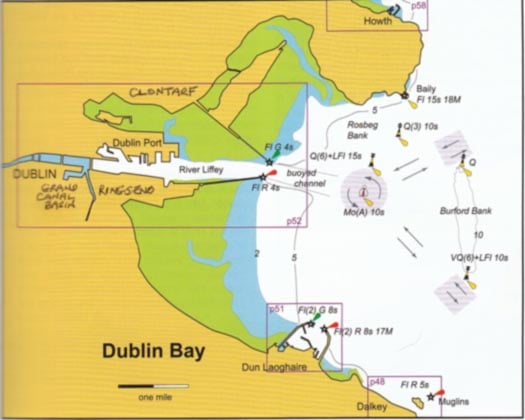
A busy little bit of water. Everyone wants a piece of the action on Dublin Bay. Plan courtesy Irish Cruising Club
You'd think that's all enough to be going along with, but bear with me. As far as administration of the built waterfront environment administration is concerned, we're only starting. King of the scene has to be Dublin Port, which really is the big beast in the administration arena. But snapping around its heels on both sides of the Liffey is Waterways Ireland, which has its canals north and south of the River. While WI may have allowed a reduction of the Spencer Dock going into the Royal Canal, across the river the sea-lock-accessed Grand Canal Basin on the south side has the potential to be the jewel in the Waterways Ireland crown, as it has a location to die for and the kind of industries which local authorities dream of – if California has its Silicon Valley, Grand Canal basin is Dublin's Silicon Harbour.
Despite the all-Ireland spread of its remit, Waterways Ireland is a smaller creature than Dublin Port, but you get an increasing sense of boundaries being claimed and defined as this once forgotten area of Dublin docklands comes rapidly alive. And of course another player in our list of statutory authorities which are very interested in the administration of the Dublin Bay area is the Docklands Development Authority, or whatever it's called now in the hope that we'll forget the debacle over the Irish Glass Bottle site.
So our chums in NAMA also have a decision-making role. And then, back in the water, the fact that the Liffey is a living river means that Inland Fisheries is another body than can be rightfully involved, as can organisations concerned with the well-being of those two important tributary rivers, the Dodder to the south and the Tolka to the north.
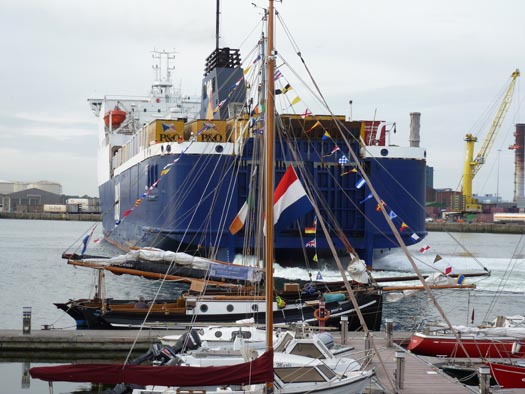
Sometimes it can seem too crowded for comfort. Ships and smaller craft share a narrow bit of water at Poolbeg. Photo: W M Nixon
All this complexity of administration in the Dublin Bay waterfront may seem convoluted enough already, but we haven't even got to Dun Laoghaire yet. There, the local council have put up the gross new library building as though to offend the other buildings on the established waterfront just as much as possible, while the Harbour Company is actively seeking ways of increasing its income – largely through accommodating cruise liners – as Dublin Port has been hoovering up the cross-channel car, passenger and ro-ro traffic through economies of scale.
Doubtless there are other statutory bodies which may be able to declare a legitimate interest in the running of Dublin Bay, but that's enough for now, so let's look instead at the consumer organisations. At a rough count, I can come up with twelve yacht, boat and sailing clubs, eight of which have premises. There are also at least six coastal rowing clubs, and five sea angling clubs. And there are several national boating bodies, all of which inevitably see a numbers concentration of their membership in the Dublin area, even if they conscientiously ensure that their administration reflects their nationwide nature.
If we really wanted to spread the net, we could come up with significant organization numbers for kite-surfers, windsurfers, canoeists and kayaks too. Plus there are two excellent links golf courses with their clubhouses right in the bay, on Bull Island. And finally, let's not forget Dublin Bay's own very special landmarks, the unused Smokestacks of Poolbeg. Boat users definitely want to keep them – at the very least, they tell us where we are. So we now have the ESB – or is it Electric Ireland these days? – central to a decision which is of great interest to Dublin Bay users.
By all means, let us know at Afloat.ie if you think there's a real need for some overall authority for the bay which can maintain the balance between sea and land, and between work, trade and recreation. It might seem like a good idea. But do we really need yet another level of bureaucracy? Yet another group of Jacks-in-Office who may even have staff with peaked caps and regulatory authorities which enable them to interfere with our natural freedoms?
It's a moot point, but I'll conclude with some experiences of how Dublin Bay is coming along as a genuine amenity for all, and look at some areas of developing interest. Of course, not everything in the garden is lovely. A public event which may have been a good idea on its first staging can become a bit jaded in its second year round, and this seemed to be the case with Dublin Port's Liffey Riverfest.
Last year, it had the attraction of novelty, and it included some Tall Ships, and also the major visit of the Old Gaffers Association international fleet in their Golden Jubilee Year. There was a busy shoreside carnival and many waterborne events including the Ballet of the Tugs and a race series for the historic Howth Seventeens. The restaurant Ship, the MV Cill Airne, provided an excellent administrative and hospitality centre, while downriver Poolbeg Yacht Boat Club's marina provided a very effective main base. It was all great fun.

The "Restaurant Boat" MV Cill Airne has proven very popular with visiting sailors in Dublin Port, but they'd like it even more if they could berth right at the ship. Photo: W M Nixon
So this year they extended the Riverfest to maybe five days in all, and for many who had been there in 2013, it seemed a bit jaded. They'd stepped up the shoreside entertainments, and noisy "fun for all the family" meant less fun for those afloat. The Howth 17s had dutifully turned up to put on a demonstration race or two, but this time round it seemed to be seen as no more than handy background moving maritime wallpaper. And as for the waterborne Ballet of the Tugs (now a daily occurrence throughout the Riverfest), those of our crew who had been there in 2013 said it wasn't nearly as good as last year, but one who hadn't been there in 2013 couldn't believe this - he thought it was absolutely marvelous seeing it for the first time.
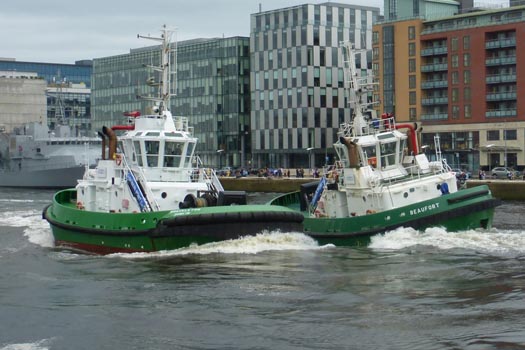
The Waterborne Ballet of the Dublin tugs Shackleton and Beaufort impresses those who haven't seen it before, but old Riverfest hands are always looking for something new. Photo: W M Nixon
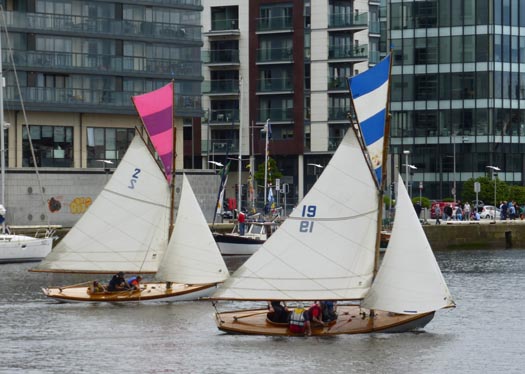
The Howth Seventeens do their duty with racing in the Liffey in the Riverfest, but for a fickle crowd on the quays always seeking fresh entertainment, the classic old boats are really just a form of moving wallpaper. Photo: W M Nixon
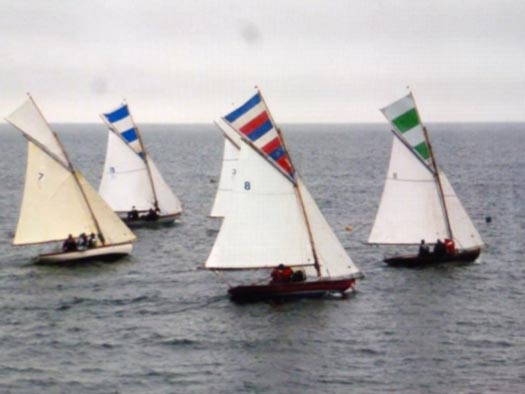
The Seventeens doing what they do best – getting in a bit of real racing. This is the leading group headed for the Clontarf At Home in July, and then on to Ringsend for Echo's Centenary Party at her birthplace. Although Echo (number 8) was the birthday girl, Deilginis (No 11) won the race to Clontarf.
Nevertheless, the old Howth Seventeens had done their duty by the Riverfest at the beginning of June knowing that later in the season, they'd have a weekend completely tailored to their own needs. The Lynch family's Howth Seventeen Echo was built in Ringsend in 1914, the only boat of the class to be built in that ancient maritime community of boatbuilders and sailmakers. So in July the class had their traditional race round the Baily to the Clontarf Yacht Boat Club At Home - an event which is totally tide dependent – then as the tide started to recede, the Seventeens got themselves round to hospitable Poolbeg.
There they were given a snug berth within the marina (most welcome as a giant cruise liner came up the river), then after a Centenary Party in PY & BC which is as near as boats can now get to Echo's birthplace in Ringsend, the party went up the quays to the Cill Airne for a dinner hosted by the Lynches, then after over-nighting at Poolbeg, on the Sunday they sailed home – mostly crewed by families – with a fair wind for Howth to round out a perfect couple of days.

The Howth Seventeens were very glad they'd been put in an inside berth at Poolbeg Marina in July after coming round from Clontarf, as the 113,000 ton cruise liner Ruby Princess was next up the river. Photo: Cillian Macken
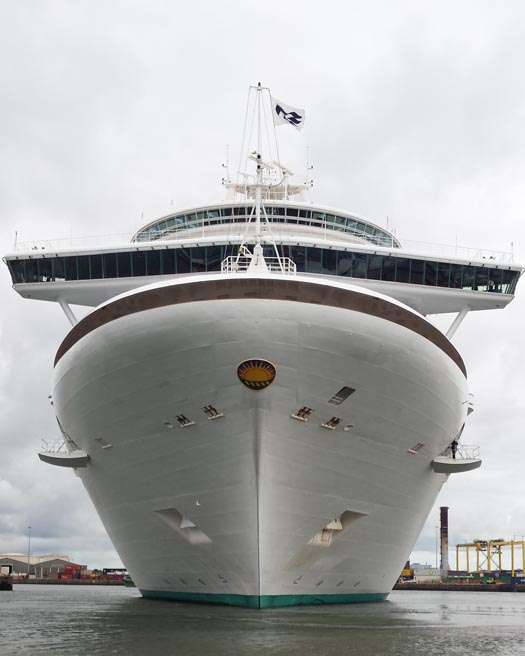
The Ruby Princess goes astern into her berth in Alexandra Basin with her bow only yards from boats in Poolbeg Marina. Photo: Cillian Macken
In other words, it was exactly the kind of weekend that most classic local one designs will enjoy hugely, but as entertainment for non-participants and spectators, it wouldn't have registered at all. This is the quandary which harbour authorities have to cope with in trying to give themselves a human face. You're either into boats and other waterborne vehicles, in which case almost anything to do with them is wonderfully entertaining. Or else you're not, in which case total incomprehension, and the ready seeking of almost any other kind of entertainment – and the noisier the better - is almost inevitable when you try to get general public interest and involvement.
Obviously the visit of a significant Tall Ships fleet is something whereby a port authority can combine both genuine maritime interest and public entertainment, but securing one is a major challenge. However, in Dublin port the new user-friendly attitudes have seen the extension of the pontoon beside the Point Depot just above the Eastlink Bridge, and while the rally of the Cruising Association of Ireland was a matter of the crews of around forty boats getting together and enjoying themselves rather than some high profile public entertainment happening, it certainly provided a useful insight into what boat visitors expect in a port.
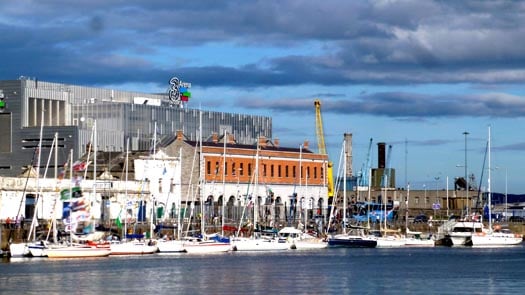
The Cruising Association of Ireland fleet was a fine sight at the new pontoon.......Photo: W M Nixon
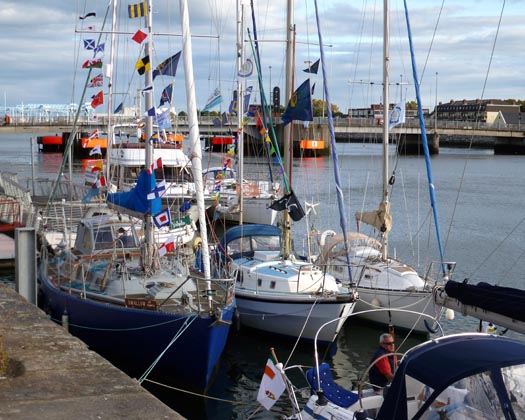
....but because of the need to keep the fairway through the Eastlink Bridge clear, they could only raft three deep. The blue boat in the foreground is Wally McGuirk's own-built 40ft steel Swallow, the last design by O'Brien Kennedy. Photo: W M Nixon
So I might as well start with the bad news. A forthright opinion came from the most experienced cruising man present. In a notably experienced group which included Wally McGuirk's very special own-built steel 40-footer, Swallow, the last boat to be designed by O'Brien Kennedy, being the most experienced is quite something. But whatever it means, it doesn't necessarily include diplomacy. When I asked this most experienced of all the cruising folk present what he thought of the new pontoons, he briskly replied: "They've put them in a stupid place. They should be up beside the Cill Airne, which is where everyone wants to be, and not down here beside the Eastlink Bridge with the likelihood of noisy crowds coming out of the Point Depot at a late hour, and the traffic on the bridge, which also means that we can only raft three deep in order to keep the channel under the bridge clear".
In fact, the CAI's end-of-season rally had a problem of success. Forty boats turned up to provide an impressive fleet but the most they could have at the pontoon, even with rafting, was thirty, so ten had to return through the bridge to Poolbeg where they'd been hospitably received the night before.
Once again, choosing the Cill Airne as the venue for the night's entertainment and meal proved a success, so ideally what's needed is berthing pontoons surrounding the ship herself. It would be mighty convenient, and also solve the inevitable security problems inherent in berthing in a city. But quite what shore-based hospitality establishments in the area would make of a ship in the river receiving such preferential treatment in the guiding of everyone's potential customers is another matter.

While the sea lock into the Grand Canal Basinon the south side of the Liffey went unoccupied the CAI fleet milled about to find berths on the North Quays. Photo: W M Nixon
However, across the river through a sea lock into the Grand Canal Basin, and you're into a snug and secure place that is surely a popular cruising destination that's just waiting to happen. Admittedly in Ireland people seem to have an aversion against having to transit a lock to enter port, but as they'll already have had to come through the Eastlink, having the lock ready can be part of the package. Within, you're totally secure, safe from big ships in the river and within easy reach of many facilities, including even the Daniel Liebeskind-designed Grand Canal Theatre.
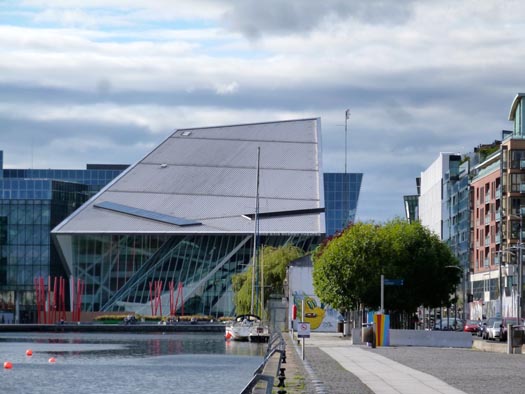
The total shelter of the Grand Canal Basin beside the Liebeskind-designed theatre. Photo: W M Nixon
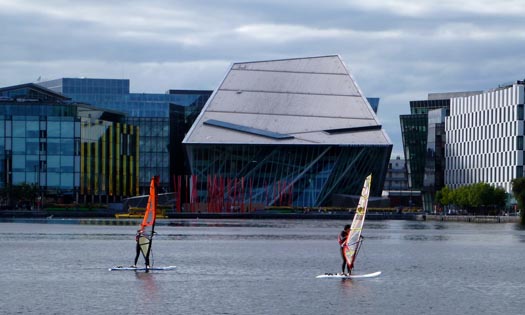
Even with other users such as trainee windsurfers and the Viking Splash ambhibian using the rad Canal Basin, there is still plenty of room for visitors. Photo: W M Nixon
Now that it has been sold to people of taste and discrimination, presumably we can hope that its clumsy current name of the Bord Gais Energy Theatre can be changed pronto. Admittedly there used to be a beloved little venue in Dun Laoghaire in the 1950s and '60s which was the Gas Company Theatre, and many a sailing person enjoyed an entertaining night of drama there. But times have moved on, and even public utilities have to be given more interesting and original names. Certainly when you have a situation where people unfamiliar with the First Official Language think that Ireland's newest and most glamorous place is known as the Bored Gosh! Energy Theatre, then something drastic yet creative has to be done.
Being in and around the Grand Canal Basin – which dates back to 1796 – really does give a sense of the past, even if many of the buildings are very new. But just across the River Dodder is Ringsend, and that is a place which is re-discovering its history as one of Ireland's most interesting maritime communities.
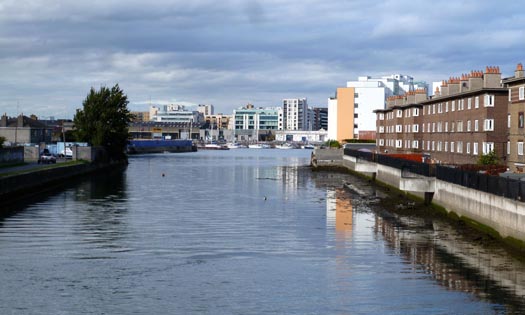
The view northward down the River Dodder from Ringsend Bridge towards the Point Depot on the other side of the Liffey. The entire riverbank on the right used to be a mix of boatyards and other marine businesses, but all that was swept away when the Thorncastle Street Dublin Corporation flats were built in 1954. Photo: W M Nixon
A packed house in Poolbeg Y & BC on Thursday night heard Cormac Lowth talk on the distinctive Ringsend sailing trawlers, and how they traced their development directly back to the arrival of Brixham trawlers from Devon, which were able to begin fishing the Irish Sea in 1818 a couple of years after the end of the Napoleonic Wars.
Brixham was a hive of fishing development and expansion at the time, and their fleets ranged the seas between Dublin Bay to the northwest and Ramsgate in Kent to the east. They originally were enticed to the facilities at the little Pigeon House harbour down along the South Wall, but soon crews were settling, such that nowadays in Ringsend there are still several prominent surnames which can be traced directly back to Devon.
With the Irish community established, there was much intermarriage, and the locals soon acquired the imported skills. Ringsend in those days was almost an island, and with its characterful fishing community, it attracted artists such as Matthew Kendrick and Alexander Wiliams, both of whom lived in Thorncastle Street, the main thoroughfare where the houses backed onto the River Dodder, along whose banks marine industries prospered.
Ship-building flourished, and one of the most talented families in this craft was the Murphy clan, who built on the banks of the Dodder (and then themselves fished) one of the mightiest cutters of them all, the 70ft St Patrick. But the demands of sailing such a boat with the standard crew of just three men and a boy were such that subsequent boats of both Brixham and Ringsend were ketch-rigged, and it's the ketch-rigged 70-footers such as Provident which we know as the classic Brixham trawler today.
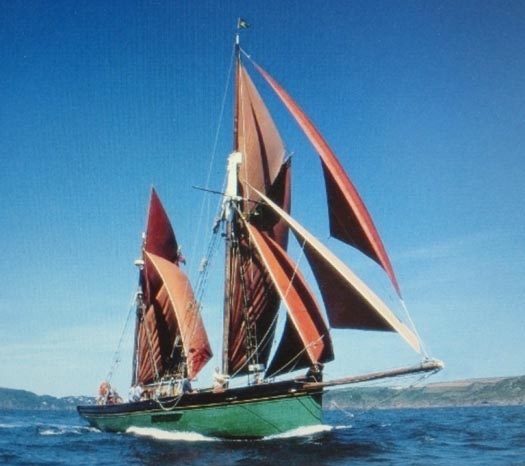
Provident, built in 1924, was one of the last and one of the best of the famous Brixham sailing trawlers.
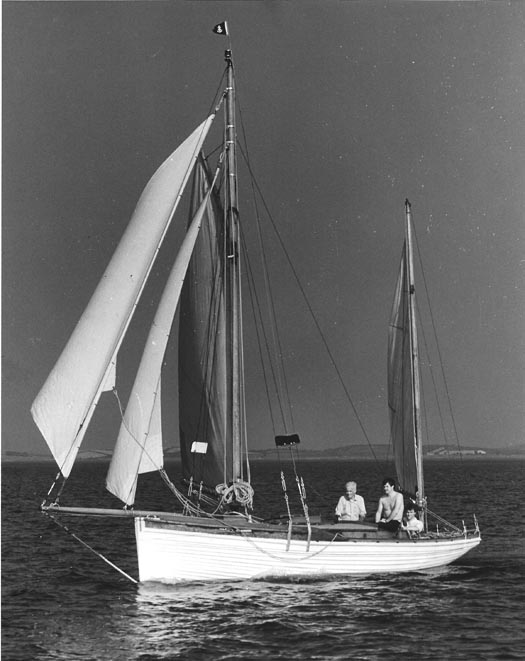
The 28ft Dolphin, built in 1924 in Ringsend, was a final acknowledgement of the hundred year old link to Brixham. She is seen here on Strangford Lough in the 1960s in Davy Steadman's ownership. Photo: Ann Clementston
Provident was built in Devon in 1924, by which time steam was already displacing sail as the preferred power system for trawlers. The effects of World War I from 1914-18 and the War of Independence in 1921 had further reduced the already much-weakened direct links between Brixham and Ringsend, but in 1924 the young designer-boatbuilder John B Kearney built Dolphin, a 28ft clinker-built gaff ketch, in Ringsend. Her design was a final salute to the Brixham connection, for in shape she was completely different from all Kearney's other yacht designs.
Dolphin has sailed through these columns before, but she deserves to be remembered again. And Cormac Lowth's wonderful lecture – it was utterly brilliant - brought the thought of her back to mind, for she's still around. So if anyone wants to make a small fortune, they first should first make a very large, indeed an enormous fortune, and then undertake the challenge of restoring Dolphin. She lies in a very sorry but still just about restorable state in a boatyard on Cork Harbour. Put her right with your large fortune, and you can be reasonably sure of having a small fortune at the end of it, but thre'll be a job which was well worth doing properly completed.

A very sad sight – Dolphin as she was in July 2014, at a boatyard on the shores of Cork Harbour. Photo: W M Nixon
Cruiseship Trio to Highlight Dublin Port Plans for Expansion
#CruiseDublinTrio- As previously reported on Afloat.ie, a partner has been sought by Dublin Port Company for the promotion and expansion of the cruise ship business, writes Jehan Ashmore.
Currently the port handles 110,000 annually which generate €50 million into the local economy and the popularity of the capital as a cruiseship destination continues by major cruise brand operators.
Among them will be the visit of three cruise ships next Wednesday and together they contribute to around 100 cruise calls this season, likewise to last year and an increase from 2012 when 89 ships visited.
So what cruiseships make up this forthcoming trio of callers, they are listed below. Notably the 5-star luxury sail-assisted Sea Cloud II is to set sail into the port as the first of these callers.
Sea Cloud II (2001/3,849grt) Flag: Malta Operator: Sea Cloud Cruises Passengers: 94 Crew: 65
For more details click HERE
MSC Magnifica (2010/92,128grt) Flag: Panama Operator: MSC Cruises Passengers: 2,500 Crew: 1,000 For more details click HERE
Thompson Spirit (1983/33,390grt) Flag: Malta Operator: Thompson Cruises Passengers: 1,254 Crew: 520 For more details click HERE
Despite the above cruiseships which are to berth in Alexandra Basin where the vast majority berth, the size of such vessels continues by considerably larger newbuilds. This has led to the port proposing to develop the sector by building a dedicated €200m cruiseship terminal.
Plans for the new terminal were submitted to An Bord Pleanála in March, which is to examine the largest infrastructural project planned in the port's history. The facility would accommodate the world's biggest ships and bring increased passenger numbers to 320,000 annually.
Dublin Port Company also aims to development the cruise industry by making the new terminal (closer to the city centre beside the East-Link bridge) into a hub-port or 'turnaround' destination where cruises start and finish.
This would create a whole new option for the cruise industry through fly-cruises marketed at lucrative international markets. In addition to attracting the domestic market where direct cruises to date have at best been sporadic.



























